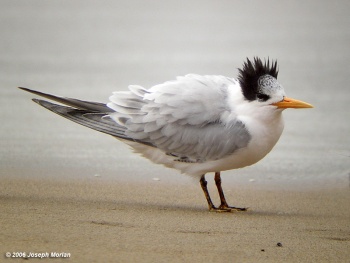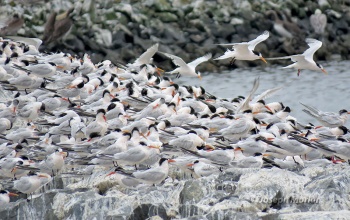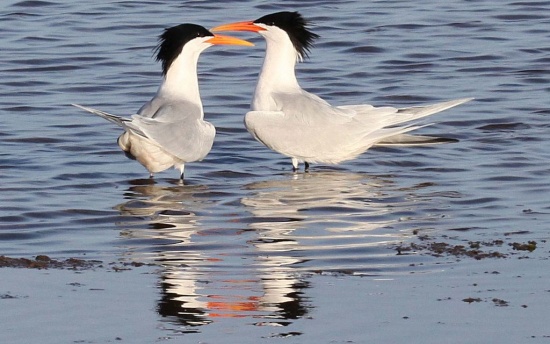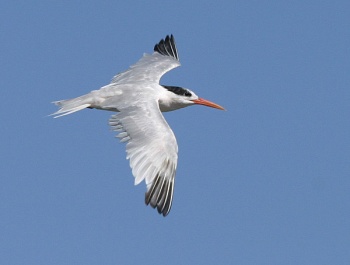- Thalasseus elegans
Sterna elegans
Identification
Length 39–43 cm (15¼-17 in), wingspan 76–81 cm, weight 200–300 g
Adult a medium-large tern with a shaggy crest
- Pale grey upperparts
- White underparts
- Black legs
- Long, slender, slightly downcurved orange bill, often with yellow at tip and more so in winter
- Black crest is very long, reaching the nape in breeding plumage
- White forehead in winter plumage (August to March)
- Often shows pink blush below.
Juveniles have a scalier pale grey back, shorter bill, and brownish legs.
Similar Species
May be confused with the larger Royal Tern, which has a thicker bill and has more white on the forehead in winter. The bill of Royal Tern is often a darker orange with less yellow, but even more important is the difference in shape, with the Royal Tern's bill being straight, not downcurved. Royal Tern also loses its black forehead earlier in the summer, even as soon as breeding starts in May; in winter plumage, Royal's black crest stops at the eye, whereas in Elegant, the black extends down through to a spot in front of the eye.
Vagrants in Europe can be confused very easily with Lesser Crested Tern, which is slightly darker above and has a grey rump. The bill is slightly shorter and thicker, and the crest is rather neater.
Distribution
The Americas: Breeds mainly in Baja California, Mexico, in the Gulf of Mexico, with a few also on the Pacific coast north to southern California. Post-breeding dispersal regular north to Oregon, with vagrants recorded north to British Columbia, and east to Texas and very rarely as far as Florida; very rare inland, apart from the near-coastal Salton Sea; one record from Tucson, Arizona, in June 2015. Winters off the Pacific coast of South America, mostly from Ecuador to Chile.
Old World: vagrants and even breeding pairs (recently verified by genetic analysis[1]) have been recorded in several western European countries from Britain and Ireland south to Spain; there are several records from France and recent records from Denmark and Britain. Some of these birds have also been seen wintering in South Africa. From the mid-1970s to mid-1980s an Elegant Tern was present each summer in a Sandwich Tern colony on the Banc d'Arguin on the western coast of France and paired with a Sandwich Tern. Another, or the same, individual was present from 1987 to at least 1996. In 1984 there were two mixed pairs and hybrid young have been produced. Recorded for the first time in Denmark in the summer of 2000, and in May 2002 the first for Britain (not yet formally accepted) was a bird at Dawlish Warren in Devon. The latter bird reappeared at the same site in July and later in Gwynedd, Wales.

Photo © by Joseph Morlan
Pescadero Beach, San Mateo County, California, USA, 9 September 2006
Taxonomy
This is a monotypic species[2]. The one named subspecies T. e. ichlus is generally considered not to be distinct[3]. Like the other Thalasseus terns, this species was formerly often placed in the genus Sterna. Hybrids with Sandwich Tern have been recorded in western Europe and in California.
Habitat
Breeds in sandy to rocky shores and islands with 95% of the population breeding on the rocky island Isla Rasa in the Gulf of Mexico off Baja California, Mexico. In winter will spend the night on sand or mudflats on the coast. Feeding is in the sea (but near the shore) and in coastal lagoons.
Behaviour
Diet
They feed by plunge-diving for fish. It usually dives directly, and not from the "stepped-hover" favoured by the Arctic Tern.

Photo © by Joseph Morlan
Half Moon Bay Harbor, San Mateo County, California, USA, 6 September 2018
Breeding
Breeding season from early April to June. Breeds in colonies together with other species of terns and gulls. In courtship display the male offers a fish to the female. Lays one egg. The young grow rapidly and group together after about six days. Parental care continues until November.
Colonies suffer predation by Heermann's Gull, Western Gull and Yellow-footed Gull.
Vocalisation
Call: a characteristic loud grating noise similar to a Sandwich Tern.
References
- Dufour, P., et al. (2017). Multilocus barcoding confirms the occurrence of Elegant Terns in Western Europe. Journal of Ornithology 158 (2): 351–361 (abstract, pdf full text).
- Clements, J. F., T. S. Schulenberg, M. J. Iliff, D. Roberson, T. A. Fredericks, B. L. Sullivan, and C. L. Wood. 2018. The eBird/Clements checklist of birds of the world: v2018. Downloaded from http://www.birds.cornell.edu/clementschecklist/download/
- Avibase
- Howell & Webb, 1995. A guide to the birds of Mexico and northern Central America. Oxford University Press. ISBN 0198540124
- Restall et al. 2006. Birds of Northern South America. Yale University Press. ISBN 9780300124156
- Alvaro Jaramillo. 2003. Birds of Chile. Princeton Field Guides. ISBN 0-691-11740-3
- Gochfeld, M., Burger, J., de Juana, E. & Garcia, E.F.J. (2017). Elegant Tern (Thalasseus elegans). In: del Hoyo, J., Elliott, A., Sargatal, J., Christie, D.A. & de Juana, E. (eds.). Handbook of the Birds of the World Alive. Lynx Edicions, Barcelona. (retrieved from http://www.hbw.com/node/54014 on 22 August 2017).
- Bridge, E.S., Jones, A.W. & Baker, A.J. (2005) A phylogenetic framework for the terns (Sternini) inferred from mtDNA sequences: implications for taxonomy and plumage evolution. Mol. Phyl. & Evol. 35(2): 459–469.
- Burness, Gary P., Kara Lefevre and Charles T. Collins.(1999).Elegant Tern (Thalasseus elegans), The Birds of North America (P. G. Rodewald, Ed.). Ithaca: Cornell Lab of Ornithology; Retrieved from the Birds of North America: https://birdsna.org/Species-Account/bna/species/eleter1
- Hudon, J. and A. H. Brush. 1990. Carotenoids produce flush in Elegant Tern plumage. Condor 92:798-801.
Recommended Citation
- BirdForum Opus contributors. (2025) Elegant Tern. In: BirdForum, the forum for wild birds and birding. Retrieved 26 April 2025 from https://www.birdforum.net/opus/Elegant_Tern
External Links
Search the Gallery using the scientific name:
Search the Gallery using the common name:
GSearch checked for 2020 platform.






